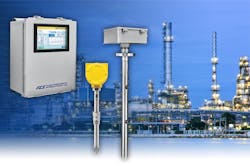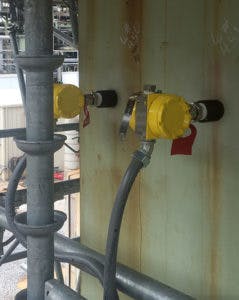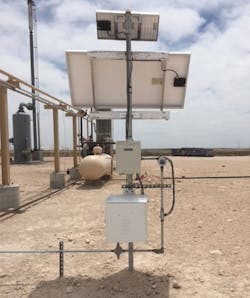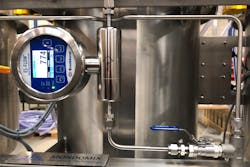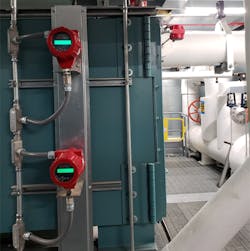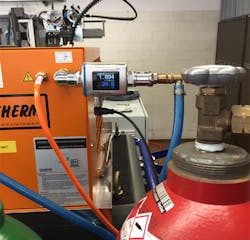Flow Control presents 2018 Innovation Awards
Flow Control continues its recognition of honoring the fluid handling industry’s ongoing commitment to manufacturing excellence by presenting the 2018 honorees. We are proud to present the latest innovations and technology breakthroughs based on an open nomination and reader voting process, which we have continued for two decades.
Thank you to everyone who participated in these awards by nominating or voting. Read about the featured technologies below. We hope to see your solution nominated next year.
Winner: Fluid Components International
Flowmeter solves refinery air-to-fuel mixture ratio problem
MT100S Multipoint Thermal Mass Flow Meter. Graphic courtesy of FCI
When process and instrument engineers at a major oil refinery on the U.S. Gulf Coast attempted to optimize their plant’s large primary boiler system, they ran into a problem controlling the burner’s air-to-fuel mixture ratio. The system’s air flow measurements were often inaccurate and erratic as well, which frustrated attempts to optimize the boiler’s efficiency.
The boiler system’s design includes a large, high-capacity air feed intake duct that provides air to the boiler’s burner. Accurately measuring the intake air flow rate is important to achieving the most efficient mixture of air and natural gas at the burner in any boiler system. The more efficient the air-to-fuel combustion ratio control, the less gas is consumed and with the least amount of off-gas, which reduces operational costs.
The problem
This boiler system’s large duct size limited the available flowmeter technologies that plant engineers could consider, and the installation location itself was less than ideal. The air flow rate at startup also was substantially less than the flow rate during normal operation, which required an air flowmeter with a high turndown ratio.
Additionally, the large air intake duct was only partially covered, which allows rain and dust into the duct. Furthermore, dense arrays of noise silencer tubes in the duct restrict the installation of flow sensors to narrow passages between the tubes.
The refinery originally installed a multipoint differential pressure (DP) averaging flowmeter. The DP meter’s reading, however, was unreliable. The DP bar had only a narrow turndown and the small orifices in the device constantly fouled and clogged with dirt particles, which resulted in excessive downtime and frequent unplanned maintenance.
Graphic courtesy of FCI
The solution
The refinery’s process and instrumentation engineering staff contacted FCI to consider an alternative solution. FCI’s local sales representative and applications engineering team recommended trying the MT100S Multipoint Thermal Mass Flow Meter (see Figure 1).
The diameter of the MT100’s multiple flow elements was small enough to fit between the silencers and their adjustable insertion lengths allowed the measuring point to be set on-site to optimize the repeatability and reliability of the air measurement. Furthermore, because the MT100’s thermal flow elements have no orifices or moving parts to clog or foul, the cost and time of
routine maintenance could be significantly reduced.
The MT100 flowmeters can be supplied with up to eight flow rate sensors. The multiple sensors are inserted at various depths within a duct, pipe or stack and their outputs are multiplexed and averaged to calculate the flow rate with high accuracy in the process line. They can be installed at multiple points around the process line as an array of single tap points or mounted across a mast.
The refinery’s engineering staff also was pleased to learn the standard MT100 meter’s large 100-to-1 turndown, ±1.75 percent of reading, ±0.5 percent of full scale accuracy, ±0.5 percent reading repeatability and wide 0.25 to 1,000 SFPS (0.07 to 305 normal meters per second) flow range would meet all of their measurement performance objectives.
The MT100 transmitter’s local readout provided the refinery plant team with a state-of-the-art, color LCD display. It continuously shows the flow rate in real time and as a trending graph, totalized flow, intake air temperature and the operational status of each flow sensor in the system.
The MT100 transmitter’s standard analog outputs include dual (2), high-resolution, 16-bit 4-20mA, NAMUR NE43 compliance and a 0-1kHz frequency/pulse. Standard digital bus communications include HART (Fieldcomm
Group-certified) and Modbus 485. A USB port for interface to PCs is also included. Optional bus communications available are Foundation Fieldbus and Profibus-PA.
The meter’s electronics include a user-programmable data logger feature to which flow rate, temperature and totalized flow, as well as fault codes, can be recorded on a removable, 8-gigabyte microSD card. The instrument also features a calibration-drift check, which can be initiated on user demand or programmed to run automatically.
For stack and flue gas environmental monitoring applications, the MT100 multipoint meters are available with an optional Continuous Emissions Monitoring System (CEMS/CERMS) package which adds special calibration checking routines compliant with U.S. Environmental Protection Agency’s requirements.
Conclusion
The newly installed MT100 multipoint flowmeters have been in continuous, successful operation for nearly a year at the refinery. The plant team has improved the efficiency of its boiler system, lowered its operational cost and reduced its environmental footprint by using FCI’s MT100 Multipoint Flow Meter to better optimize the boiler’s fuel-to-air mixture ratio with more accurate, dependable air flow measurement and by eliminating unplanned maintenance.
Honoree: Fox Thermal
Oil and gas operators meet regulations with accurate gas flow measurement
Graphic courtesy of Fox Thermal
In oil and gas upstream gas measurement applications, operators need accurate and reliable gas flow measurement for harsh environments. The Model FT4X thermal mass flowmeter from Fox Thermal was used successfully for allocation, tank vapor and flare gas for one company’s need to comply with new Bureau of Land Management regulation requirements.
The company researched technologies other than thermal mass flowmeters, but liked the sizing, price and the quick and easy installation of thermal mass flowmeters over other technology types including the orifice meter. Thermal mass flowmeters do not require pressure and temperature compensation with thermal mass flowmeters, unlike differential pressure, tortex and turbine meters. Thermal mass flowmeters also offer a no-moving-parts design, excellent turndown, virtually no pressure drop and a lower price tag than many other technologies on the market.
The Model FT4X is equipped with Gas-SelectX, which solved a problem for the customer’s changing gas composition of the flare gas. Each FT4X is programed to measure multiple gases available in the Gas-SelectX gas selection menus. Any number of gases available in the Mix menu and O&G menu can be mixed in any percentage equaling 100 percent, as shown in Table 1.
Another problem it solved was with the measurement of the tank vapor on-site. It reads very low flow rates with a higher accuracy than competitors, resulting in a good turndown ratio.
The FT4X was used for flare gas measurement at this oil and gas location. The Model FT4X accuracy spec was right and it had all of the necessary features preferred by the customer for the application.
Fox Thermal flowmeters include digital sensors. The Model FT4X is equipped with the direct digitally controlled sensor (DDC-Sensor) that provides a technology platform for calculating accurate gas correlations. The correlation algorithms allow the meter to be calibrated on a single gas in the factory while providing the user the ability to select other gases in the Gas-SelectX gas menu(s). Many sensors utilize fragile, cantilevered (only welded at one end) elements, whereas the sensor elements of the DDC-Sensor are welded to the sensor window at both ends for extra stability and strength. This enhanced design eliminates the sensor element vibration — found most often at high flow rates of a flaring event — which can potentially lead to metal fatigue and failure.
The Model FT4X comes equipped with an advanced intrinsic data logger for advanced record-keeping and data retention. The features of this data logger held the biggest draw for this customer. The settable contract time, the 40-daily totals, and the 7-year history in the logger along with a totalizer that logs power outages and other events make record-keeping a snap.
Honoree: Bronkhorst High-Tech
Ultrasonic measurement of additive supply in candy manufacturingFlow measurement is gaining importance within the confectionery industry. Haas Mondomix provides solutions and machinery to confectionery manufacturers. To accurately measure liquid additives during the production of candy, Bronkhorst was asked to supply a flowmeter that fit customer requirements. By using Bronkhorst’s newest product, the ES-FLOW ultrasonic volume flowmeter, the measurement accuracy could be improved, and consequently, the quality control of the manufacturing process.
Application requirements
To give a piece of candy its own taste, texture and appearance, additives such as colorings, flavorings and acids are added during the manufacturing process.
The flows of coloring agent, flavoring agent and acid come from three individual reservoirs and enter the main stream through three separate small pumps. Each of these pumps is controlled by a programmable logic controller, where the main stream is the master.
By measuring how much additive is added to the main stream, the consumption of these additives has to become more efficient while keeping the quality of the end product at a constant, high level.
Process solution
Bronkhorst supplied three ES-FLOW ultrasonic flowmeters. Each instrument measures the flow of coloring, flavoring and acid. Because these fluids are highly concentrated, only small amounts have to be added. These amounts can be measured with the ultrasonic flowmeter, as the measurement range is within 4 to 1,500 milliliters per minute with a precision of +/- 1 percent reading. The overall performance and user-friendly operation of the ES-FLOW instrument are the main reasons for choosing this device.
The ES-FLOW is constructed and designed for hygienic applications. The flowmeter is equipped with a straight SS316 sensor tube to ensure no dead volume and excellent cleanability. The display can be used for read-out and control and is mounted in the stainless-steel housing. The back of the display features a connector for connection to a pump or a control valve, and with proportional-integral-derivative (PID) control on-board, a process can be controlled through the display.
Natural colorings and flavorings are costly agents. Controlled and efficient use of these substances will yield a better-quality product and save on raw materials. By using the ultrasonic flowmeter, the quality control of the process is improved.
In the old days, poor quality was observed by looking at the candy at a rather late stage, resulting in entire batches of candy that had to be defined as "second choice." Now, by using the ES-FLOW volume flowmeter, poor quality — if any — will be detected earlier.
Depending on the type of candy to be produced, the amounts and types of colorings, flavorings and acids will vary. Because the ES-FLOW is liquid-independent and can be used for all liquids without recalibration, the devices are incorporated as standard option in Haas Mondomix equipment for confectionery manufacturing.
Honoree: Sierra Instruments
Big-3 improves plant operational efficiency
Graphic courtesy of Sierra Instruments
Facilities managers and engineers must manage all the flow energy in their facilities with the mandate from upper management to improve productivity and save money on energy costs. Flow energy is defined as "flows that cost money." These flows include natural gas, compressed air, water and steam. Traditionally engineers have worked with many different flowmeter technologies and companies depending on the type of fluid measured. With the launch of the Big-3, Sierra introduced one complete flow energy management solution for all gas, liquid and steam flow measurement backed a team of flow experts. Sierra manufactures, calibrates, commissions and supports QuadraTherm 640i/780i thermal flowmeters (+/-0.5 percent of reading) for gas flow measurement, InnovaMass 240i/241i vortex flowmeters for steam and the clamp-on InnovaSonic 207i ultrasonic flowmeter for hot/chilled water.
Chemical plant improves boiler efficiency
Plant engineers at a large chemical plant in China optimized their boiler efficiency with Sierra’s Big-3 gas, liquid and steam flowmeters. The chemical plant produces purified terephthalic acid (PTA), a precursor to polyethylene terephthalate (PET), the material used worldwide in plastic bottles and textiles. The chemical plant generates steam and electricity from its on-site power plant using coal as fuel. Additionally, it has a wastewater treatment station that produces methane, which is then flared off. Both processes are major emitters of greenhouse gases.
Government regulations require the chemical plant to reduce its carbon dioxide emissions, so plant engineers modified their four boilers to burn coal and the previously flared-off waste gas (methane), estimating a savings of about $0.5 million in coal each year. Working with Sierra as a single-source supplier, they reworked the design of the boilers and installed QuadraTherm 640i insertion thermal mass flowmeters to measure the combustion air and waste gas fuel, ensuring optimal combustion. One 640i thermal flowmeter measures the waste gas flow, while the other four provide submetering of this gas stream to each boiler. Another four meters measure preheated (200°C/392°F) combustion air to each boiler, optimizing the fuel-to-air ratio.
To further optimize boiler efficiency, plant engineers measured the inlet feed water to the boiler with the clamp-on InnovaSonic 207i ultrasonic flowmeter. The 207i is designed to achieve high accuracy at low and high flows, save time with no pipe-cutting or process shutdown and to be unaffected by external noise. To finish the project, engineers installed the InnovaMass 241i multivariable vortex steam flowmeter to accurately measure the steam flow delivered from the boilers to the turbine generator for submetering to the other plant processes. The 241i multivariable vortex flowmeter provides steam accuracy of 1 percent of reading, 30:1 turndown plus pressure and temperature compensation.
ONE integration & automation solution
The Big-3 share common Raptor firmware and software for easy integration, setup and serviceability, enabling operators to leverage their knowledge between the different platforms.
- Software apps allow plant engineers and managers to mine and analyze data quickly to make effective productivity decisions.
- All patented (thermal, vortex and ultrasonic) sensors provide accuracy and extensive flow knowledge through multivariable functionality.
- Investment in assets for water, steam and gas calibration is supported by Sierra USA.
Honoree: Endress+Hauser
Electromagnetic flowmeter maintains cooling in welding applications
By using a Picomag electromagnetic flowmeter in the cooling return line, one can verify the flow rate and the temperature simultaneously. Graphic courtesy of Endress+Hauser
In welding applications, constant cooling of the welding gun is important to offset the high currents and temperatures of welding. The welding gun is cooled with about 0.5 gallons per minute of cooling fluid at 77°F. Because of the high thermal wear of the welding hat, the cooling liquid can leak, possibly causing plant downtime or damage to sensitive equipment. By using a Picomag electromagnetic flowmeter in the cooling return line, one can verify the flow rate and temperature simultaneously.
The Picomag combines a sensor and transmitter in the same housing with a 1.4-inch TFT color display that shows flow, totalizer and temperature readings as well as warning and diagnostic messages. It mounts directly in the ½-inch fluid line for easy installation in the crowded welding apparatus. The Picomag and its display are installed in the welder’s line of sight.
With its switch output, an alarm can easily be set if flow or temperature limits are reached. Alarms can be sent over IO-Link to a central location, viewed with a smartphone or tablet via a Bluetooth connection and Endress+Hauser’s free SmartBlue App and/or displayed on the flowmeter screen. The Bluetooth wireless interface allows direct access to process and diagnostics data and enables users to configure the measuring device on the fly. It can be operated and configured on Android and iOS devices via the app.
The alarm tells the welder that quality might decrease or equipment may get damaged. The screen shows flow and temperature values instantly as well as diagnostic messages for more secure welding and less downtime.
Thorsten Undi, welding expert, said, "After using Picomag, the welding issues and downtime decreased because of the additional information received from the device. Moreover, the … SmartBlue App saves me time in setting up the device without using the documentation."

